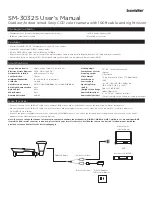
- 7 -
CAUTION
Others
•
Exposing the sensor to a gas for a long time or a high-concentration gas may result in the gas
alarm remaining on for a longer period. If the exposure occurs, allow the instrument to draw
fresh air for more than 5 minutes (recommendation), and then perform air calibration again.
•
Pressing buttons unnecessarily may change the settings, preventing alarms from activating
correctly. Operate the detector using only the procedures described in this operating manual.
•
Do not drop or shock the detector. The accuracy of the gas detector may deteriorate.
•
Do not jab the buzzer opening with a sharp-pointed item. Doing so may cause a failure or
damage.
•
Do not remove the panel sheet on the display. The water-proof and dust-proof performances
will be deteriorated.
•
Do not affix a label or the like on the infrared port. Infrared communications can no longer be
conducted.
•
The operating environment may include gases that have harmful effects on the sensor of the
detector. The detector cannot be used in the presence of the following gases:
(1) High-concentration sulfides (such as H2S, SO2, etc.)
(2) Halogen gases (such as chloride compounds, etc.)
(3) Silicone (Si compounds)
(4) High-concentration solvent gases
Do not use the detector in the presence of the above (1), (2), and (3) gases (such as
high-concentration sulfides, halogen gases, silicone, etc.), which may shorten the sensor life
significantly or cause malfunctions such as inaccurate readings.
In case the gas detector is used for detection in the presence of silicone, etc., be sure to check
the gas sensitivities before using it again.
If the above (4) gas (high-concentration solvent gas) is exposed, a crack may occur in the
detector. Thus, do not use high-concentration solvent gases.
About battery replacement
•
Always turn off the power before replacing the batteries.
•
Replace both of the batteries with new ones at one time.
•
Pay attention to the polarities of the batteries.
Usage
•
In a low-temperature environment, the operating time is shortened due to battery performance.
•
At low temperatures, the responses of the LCD display may slow down.
•
Perform air calibration under pressure and temperature/humidity conditions close to those in
the operating environment and in fresh air.
•
Perform the air calibration after the reading is stabilized.
•
If there is a sudden temperature change of 15ºC or more between the storage and operational
location, turn on the power of the gas detector, let it stand for about 10 minutes in a similar
environment to the operational location, and perform air calibration in fresh air before using it
•
When cleaning the gas detector, do not splash water over it or use organic solvents such as
alcohol and benzene on it. The surface of the gas detector may be discolored or damaged.
•
If the gas detector is not used for a long time, turn on the power at least once every six months
and check that the pump draws in air (about three minutes). The gas detector, when not
activated for a long time, may cease to work because of hardening of the grease in the pump
motor.
•
If the gas detector is not used for a long time, store it after removing the batteries. Battery leaks
may result in fire, injury, etc.
•
When the detector is used again after a long period storage, always perform an air calibration.
For information on readjustment including air calibration, please contact Matheson.








































